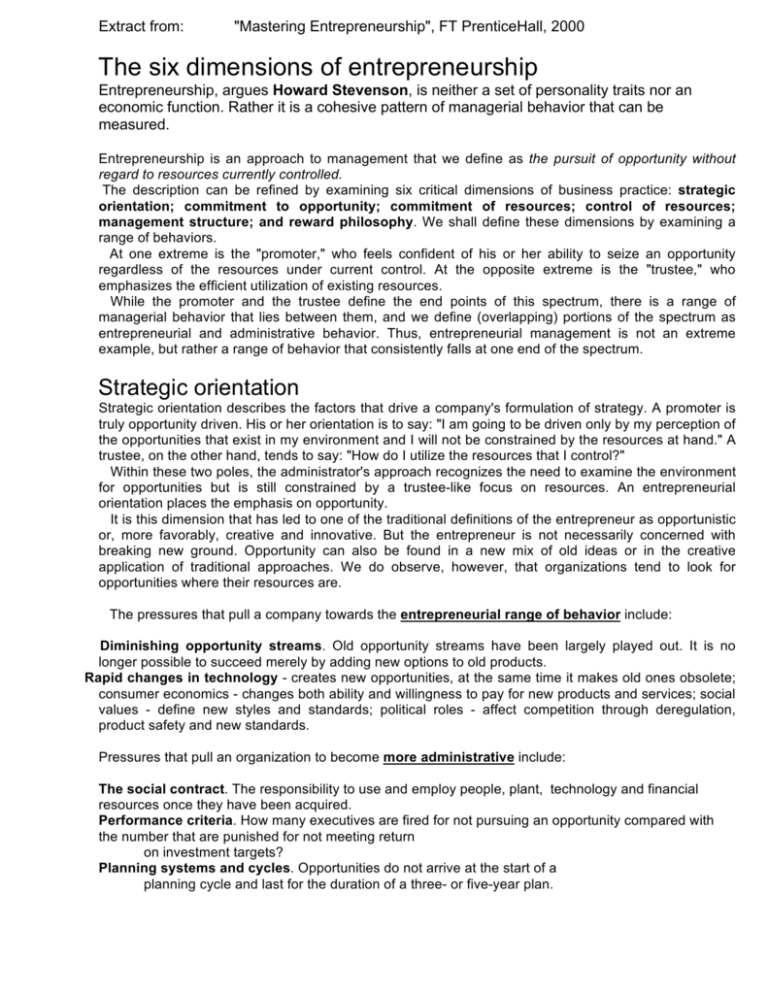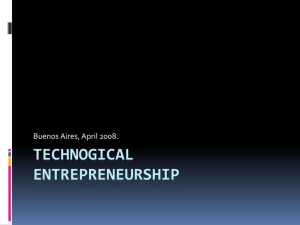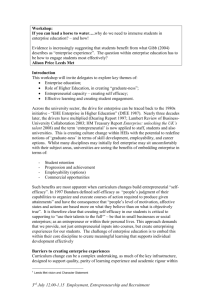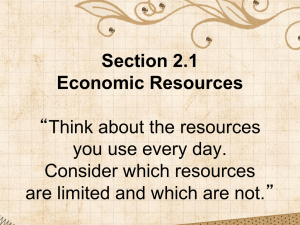The six dimensions of entrepreneurship
advertisement

Extract from: "Mastering Entrepreneurship", FT PrenticeHall, 2000 The six dimensions of entrepreneurship Entrepreneurship, argues Howard Stevenson, is neither a set of personality traits nor an economic function. Rather it is a cohesive pattern of managerial behavior that can be measured. Entrepreneurship is an approach to management that we define as the pursuit of opportunity without regard to resources currently controlled. The description can be refined by examining six critical dimensions of business practice: strategic orientation; commitment to opportunity; commitment of resources; control of resources; management structure; and reward philosophy. We shall define these dimensions by examining a range of behaviors. At one extreme is the "promoter," who feels confident of his or her ability to seize an opportunity regardless of the resources under current control. At the opposite extreme is the "trustee," who emphasizes the efficient utilization of existing resources. While the promoter and the trustee define the end points of this spectrum, there is a range of managerial behavior that lies between them, and we define (overlapping) portions of the spectrum as entrepreneurial and administrative behavior. Thus, entrepreneurial management is not an extreme example, but rather a range of behavior that consistently falls at one end of the spectrum. Strategic orientation Strategic orientation describes the factors that drive a company's formulation of strategy. A promoter is truly opportunity driven. His or her orientation is to say: "I am going to be driven only by my perception of the opportunities that exist in my environment and I will not be constrained by the resources at hand." A trustee, on the other hand, tends to say: "How do I utilize the resources that I control?" Within these two poles, the administrator's approach recognizes the need to examine the environment for opportunities but is still constrained by a trustee-like focus on resources. An entrepreneurial orientation places the emphasis on opportunity. It is this dimension that has led to one of the traditional definitions of the entrepreneur as opportunistic or, more favorably, creative and innovative. But the entrepreneur is not necessarily concerned with breaking new ground. Opportunity can also be found in a new mix of old ideas or in the creative application of traditional approaches. We do observe, however, that organizations tend to look for opportunities where their resources are. The pressures that pull a company towards the entrepreneurial range of behavior include: Diminishing opportunity streams. Old opportunity streams have been largely played out. It is no longer possible to succeed merely by adding new options to old products. Rapid changes in technology - creates new opportunities, at the same time it makes old ones obsolete; consumer economics - changes both ability and willingness to pay for new products and services; social values - define new styles and standards; political roles - affect competition through deregulation, product safety and new standards. Pressures that pull an organization to become more administrative include: The social contract. The responsibility to use and employ people, plant, technology and financial resources once they have been acquired. Performance criteria. How many executives are fired for not pursuing an opportunity compared with the number that are punished for not meeting return on investment targets? Planning systems and cycles. Opportunities do not arrive at the start of a planning cycle and last for the duration of a three- or five-year plan. Commitment to opportunity As we move on to the second dimension it becomes clear that the definition of the entrepreneur as creative or innovative is not sufficient. There are innovative thinkers who never get anything done. It is necessary to move beyond the identification of opportunity to its pursuit. The promoter is willing to act in a very short time frame and to chase an opportunity quickly. The duration of their commitment, not their ability to act, is all that is in doubt. Commitment for the trustee is time consuming and, once made, of long duration. Trustees move so slowly that it sometimes appears they are stationary; once there, they seem frozen. It is the willingness to get in and out quickly that has led to the entrepreneur's reputation as a gambler. However, the simple act of taking a risk does not lead to success. More critical is knowledge of the territory they operate in. Their familiarity with their chosen field means they have the ability to recognize patterns as they develop and the confidence to assume that missing elements will take shape as they foresee. This early recognition enables them to get a jump on others in commitment to action. Pressures that pull a business towards this entrepreneurial end of the spectrum include: Action orientation. Enables an organization to make first claim to customers, employees and financial resources. Short decision windows. Due to the high costs of late entry, including lack of competitive costs and technology. Risk management. Involves managing the organization's revenues in such a way that they can be rapidly committed to or withdrawn from new projects. Limited decision constituencies. Requires a smaller number of responsibilities and permits greater flexibility. In contrast, administrative behavior is a function of other issues: Multiple decision constituencies. A greater number of responsibilities, necessitating a more complex, lengthier decision process. Negotiation of strategy. Compromise in order to reach consensus and resultant evolutionary rather than revolutionary commitment. Risk reduction. Study and analysis to reduce risk slows the decision-making process. Management of fit. To assure the continuity and participation of existing players, only those projects that "fit" existing corporate resources are acceptable. Commitment of resources Another characteristic we observe in good entrepreneurs is a multi-staged commitment of resources with a minimum commitment at each stage or decision point. The issue for the entrepreneur is this: what resources are necessary to pursue a given opportunity? There is a constant tension between the amount of resources committed and the potential return. The entrepreneur attempts to maximize value creation by minimizing the resource set and must, of course, accept more risk in the process. On the other hand, the trustee side deals with this challenge by careful analysis and largescale commitment of resources after the decision to act. Entrepreneurial management requires that you learn to do a little more with a little less. On this dimension we have the traditional stereotype of the entrepreneur as tentative, uncommitted or temporarily dedicated - an image of unreliability. In times of rapid change, however, this stepped, multi-staged commitment of resources is a definite advantage in responding to changes in competition, the market and technology. The process of committing resources is pushed towards the entrepreneurial domain by several factors: Lack of predictable resource needs. Forces the entrepreneur to commit less up front so that more will be available later on if required. Lack of long-term control. Requires that commitment matches exposure. If control over resources can be removed by environmental, political or technological forces, resource exposure should also be reduced. Social needs. Multi-staged commitment of resources brings us closer to "small is beautiful" by allowing appropriate levels of resource intensity. International demands. Pressures that we use no more than our fair share of the world's resources. The pressures within large corporations, however, are in the other direction, toward resource intensity: Personal risk reduction. Any individual's risk is reduced by having excess resources available. Incentive compensation. Excess resources increase short-term returns and minimize the period of cash and profit drains - typically the objects of an incentive compensation system. Managerial turnover. Creates pressures for steady cash and profits gains, which encourage short-term, visible success. Capital allocation systems. Generally designed for one-time decision making, these techniques assume that a single decision point is appropriate. Formal planning systems. Once a project has begun, a request for additional resources returns managers to the morass of analysis and bureaucratic delays. Managers are inclined to avoid this by committing the maximum amount of resources up front. Control of resources Entrepreneurs learn to use other people's resources well and to decide over time what resources they need to bring in-house. Good managers also learn that there are certain resources you should never own or employ. Very few real estate companies employ an architect. They may need the best but they do not want to employ him or her because the need for that resource, though critical to the success of the business, is temporary. The stereotype of the entrepreneur as exploitative derives from this dimension. The entrepreneur is adept at using the skills, talents and ideas of others. Viewed positively, this ability has become increasingly valuable in the changed business environment. It need not be parasitic in the context of a mutually satisfying relationship. Pressures towards this entrepreneurial side come from: Increased resource specialization. An organization may need a specialized resource such as a high-tech patent attorney or state of the art circuit test equipment, but only for a short time. By using rather than owning, a company reduces its risk and fixed costs. Risk of obsolescence. Reduced by using rather than owning an expensive resource. Increased flexibility. The cost of exercising the option to quit is reduced. Administrative practices are the product of pressures in the other direction: Power, status and financial rewards. Determined by the extent of resource ownership and control in many corporations. Co-ordination. The speed of execution is increased because an executive has the right to request certain action without negotiation. Efficiency. Enables an organization to capture, at least in the short run, all the profits associated with an operation. Inertia and cost of change. It is commonly believed that it is good management to isolate the technical core of production from external shocks. This requires buffer inventories and control of raw materials and distribution channels. Ownership also creates familiarity and an identifiable chain of command, which becomes stabilized with time. Industry structures. Encourage ownership to prevent being pre-empted by the competition. Management structure The promoter wants knowledge of his or her progress via direct contact with all of the principal actors. The trustee wants relations more formally, with specific rights and responsibilities assigned through the delegation of authority. The decision to use and rent resources and not to own or employ them requires the development of an informal information network. Only in systems where the relationship with resources is based on ownership or employment can resources be organized in a hierarchy. Informal networks arise when the critical success elements cannot be contained within the bounds of the formal organization. Many people have attempted to distinguish between the entrepreneur and the administrator by suggesting that being a good entrepreneur precludes being a good manager. The entrepreneur is stereotyped as egocentric and idiosyncratic and thus unable to manage. However, although the managerial task is substantially different from that of the entrepreneur, management skill is nonetheless essential. The variation lies in the choice of appropriate tools. More entrepreneurial management is a function of several pressures: Need for co-ordination of key non-controlled resources. Results in need to communicate with, motivate, control and plan for resources outside the organization. Flexibility. Maximized with a flat and informal organization. Challenge to owner's control. Classic questions about the rights of ownership as well as governmental, environmental, health and safety restrictions undermine the legitimacy of control. Employees' desire for independence. Creates an environment where employees are unwilling to accept hierarchical authority in place of authority based on competence and persuasion. At the other end of the spectrum, pressures pushing towards more administrative behavior include: Need for clearly defined authority and responsibility. To perform the increasingly complex planning, organizing, co-ordinating, communicating and controlling required in business. Organizational culture. Often demands that events be made routine. Reward systems. Encourage and reward breadth and span of control. Reward philosophy Finally, entrepreneurial companies differ from administratively managed ones in their philosophy regarding reward and compensation. Entrepreneurial organizations are more explicitly focussed on the creation and harvesting of value. In start-up situations, the financial backers of the organization - as well as the founders themselves - have invested cash and want cash out. As a corollary of this value-driven philosophy, entrepreneurial companies tend to base compensation on performance (where performance is closely related to value creation). Entrepreneurial companies are also more comfortable rewarding teams. More administratively managed companies are less often focussed on maximizing and distributing value. They are more often guided in their decision making by the desire to protect their own positions and security. Compensation is often based on individual responsibility (assets or resources under control) and on performance relative to short-term profit targets. Reward in such organizations is often heavily oriented toward promotion to increased responsibility levels. The pressures that pull companies towards the promoter end of the spectrum include: Individual expectations. Increasingly, individuals expect to be compensated in proportion to their contribution rather than merely as a function of their performance relative to an arbitrary peer group. In addition, individuals seemingly have higher levels of aspiration for personal wealth. Investor demands. Financial backers invest cash and expect cash back, and the sooner the better. Competition. Increased competition for talented people creates pressure for organizations to reward these individuals in proportion to their contributions. On the other side a variety of pressures pull companies towards more trustee-like behavior: Societal norms. We still value loyalty to the organization and find it difficult to openly discuss compensation. Impacted information. It is often difficult to judge the value of an individual's contribution. Demands of public shareholders. Most public shareholders are simply uncomfortable with compensation that is absolutely high, even if it is in proportion to contribution. Summary In developing a behavioral theory of entrepreneurship it becomes clear that entrepreneurship is defined by more than a set of individual traits and is different from an economic function. It is a cohesive pattern of managerial behavior. This perspective on entrepreneurship highlights what we see as a false dichotomy: the distinction drawn between entrepreneurship and intrapreneurship. Entrepreneurship is an approach to management that can be applied in start-up situations as well as within more established businesses. As our definition suggests, the accumulation of resources that occurs as a business grows is a powerful force that makes entrepreneurial behavior more difficult in a larger company. However, the fundamentals of the behavior required remain the same. Copyright @ Howard Stevenson 1997







